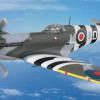Search the Community
Showing results for tags 'RAF Bombers'.
-
As modellers and, dare I say it, amateur historians of 1940s British air power, we sometimes throw terms like "Fighter Command" and "Bomber Command" around without really considering what they mean. For many, I am sure, mentioning Bomber Command conjures images of Lancasters and The Dambusters. Forgive me, therefore, if I indulge in a little background history before I get stuck into making models. As I'm sure you may recognise, this thread could well be the start of something longwinded. I don't expect swift progress on any of the planned builds, and neither should you. British bombers tended to be large and often complex machines, so it's fair to expect the same of this thread! Origins Let's start at the beginning. The Royal Air Force was formed in April 1918 by the merger of the British Army's Royal Flying Corps and the Admiralty's Royal Naval Air Service. By the time of the merger, both air wings had been more or less working together anyway. Although the world's first official independent air force, the nascent RAF had a difficult childhood. Both older military arms wanted their toys back, doing all they could to stifle the newcomer before it could get started. The British government didn't really help, starving the RAF of cash, and slashing it to a fraction of the size of the circa 300,000 men with which it ended the war. The service was saved essentially by Sir Hugh Trenchard, its founding father in many respects and by the 1920s the first Chief of the Air Staff, who argued that air power would be a cost-effective method of policing parts of the British Empire. In 1921, the RAF was given responsibility for all British forces in Iraq, aiming to "police" tribal unrest. The RAF was also deployed to Afghanistan, on its own, to deal with other tribal issues. Back home, the RAF was still fighting to survive. Self-promotion, with events like the Hendon air pageants and taking part in (and winning) the Schneider Trophy air races, were very successful in keeping the air force in the public consciousness. At the same time, the still new technology of flight was seen as glamorous and air-mindedness, particularly among the wealthier classes, was taking hold. Air Defence of Great Britain The Steel-Bartholomew Committee, meeting in 1923, recommended that defence of the British Isles, and London in particular, as then capital city of a global empire, should be handled by the new Air Ministry instead of the War Office. The defence structure was to involve the RAF's Metropolitan Air Force, with 52 squadrons of mostly bombers, plus the Royal Artillery and Royal Engineers to handle anti-aircraft artillery and searchlights. It also recommended setting up a volunteer Observer Corps. Air Defence of Great Britain (ADGB) was formed in 1925, and was organised in three defensive zones: Inner Artillery Zone (IAZ), over London Air Fighter Zone (AFZ), divided in two areas controlling regular squadrons, the so-called Wessex Bombing Area and Fighting Area Outer Artillery Zone (OAZ), a narrow belt along the English east and south coast from Suffolk to Sussex You may well get the impression from that arrangement that much of the military dogma in Britain deemed France as the next potential enemy. It is true, at the time, that the French military was the strongest and best equipped on the Continent and France was also a major colonial power, so perhaps the fears were somewhat justified. This thinking persisted for some time. Planning and developing a British strategic bomber force without a clear idea of who the enemy might be led to some poor decisions about how to equip what was intended to be a deterrent force. Until the mid-1930s, also partially due to limited resources and factory capacity, the bulk of the RAF's bomber force comprised light biplane day bombers, like the Hawker Hart and Hind, cheap and easy to build. Someone at the Air Ministry finally realised that bigger and better machines would be required. Specifications were set out, though still somewhat hampered by various international arms limitations treaties, and the results were aircraft like the Handley Page Heyford and Fairey Hendon. Eventually, specifications laid the groundwork for the aircraft with which the RAF would enter the next war, the Hampden, Wellington and Whitley, plus the light and medium bombers of the Battle and Blenheim. Advanced designs for four-engined heavy bombers were well under way by the time war broke out in 1939. Rethinking ADGB In 1936 ADGB was abolished. In its place, four new Commands were created: Fighter, Bomber, Coastal and Training. Fighter Command would deal with defending the British Isles, Coastal would protect shipping around the coasts, Training needs no explanation, leaving Bomber Command to handle the task of deterring and attacking a potential enemy. (I am, of course, effectively ignoring much of the geopolitical landscape of the late 1920s and 1930s. I think most of us know what the situation was, and I'm trying to explain simplistically how Bomber Command came into existence.) The new Bomber Command inherited a motley selection of aircraft. Arranged into four Groups, oddly numbered 1, 2, 3 and 6, the last being an auxiliary Group, the Command could field squadrons flying a lot of biplanes, some of which could date their designs right back to the Great War. Light bombers like Hawker Hinds, medium bombers like the Boulton-Paul Overstrand, heavies like the Vickers Virginia, were being supplemented by new machines like the Handley Page Heyford and the massive Fairey Hendon, the first all-metal monoplane bomber in the RAF. Modernisation, frankly, couldn't come quickly enough. Happily, the previously mentioned Hampden/Hereford, Wellington and Whitley were starting to enter service, and plans were already in train for the big four-engined heavies. And to the models So, what do I have in store? Well, as you might expect, we modellers in the gentleman's scale have been pretty well served by Airfix over the past few years. Already built, I have the Bristol Blenheim MkIV twin-engined light bomber and the Armstrong Whitworth Whitley MkV. The latter is lined up for a mild repaint to correct some dodgy transfers, so may make an appearance here in time. News from afar tells me that the long-awaited Ffrom Fairey Battle will be with us soon (May 2023 is currently mooted), so that's a big hole in the light bomber fleet to be plugged. I did attempt to upgrade the rather elderly Airfix Handley Page Hampden a few years ago, but happily I now have this Valom kit to replace it. Ignore what it says on the box, because I know the right parts for the RAF bomber are inside. Good old Airfix is providing a pair of Wellingtons. There's a joke in there somewhere, but I can't find it. Take no heed to what markings come in the box. I'm still to choose suitable squadron markings, and I'm keen to do at least one of these to represent either Czech or Polish air crews. Not photographed is a Revell Handley Page Halifax MkI with some aftermarket bits to improve the Merlin engines. A nice vintage 1975 box of the Short Stirling. Why, you may ask, have I not gone for the Italeri kit? Well, right now they are like hens' teeth, plus having reviewed various builds and noted how much effort builders went to in order to minimise the rather excessive panel lines, I reckoned a tenner spent on the old Stirling plus some fun scratching interior parts and "upgrading" the exterior in ways I've not yet explored was a better bet. Then there's this. Wait, what? Any fule no that the Lancaster wasn't around in 1940. What gives? Well, what gives is the engines. I had planned to nick a couple of the Bristol Hercules engines and props for another kit, but they might just get purloined en masse to upgrade the Stirling. Meanwhile... This quite heavy collection of parts from Blackbird Models will let me de-evolve Roy Chadwick's masterpiece into the Avro Manchester. Now, the more astute among you might have noticed several of these aircraft don't strictly meet my 1940 criteria. This is true. I have a self-imposed rule that I only build models of aircraft in squadron service at any time from 1 January to 31 December 1940. That is actual squadron service, so no prototypes or one-offs or other oddities. No De Havilland Mosquitos, I'm afraid. When it comes to the bombers, however, I am happy to bend that rule. While it is true the Stirling, Manchester and Halifax did not fly operational bombing sorties until the early part of 1941, they were in actual squadrons towards the end of 1940 so crews could begin converting to them and working up to full operations. This bend of my rule means I can begin to show how Bomber Command was being set up to prosecute the rest of the war, which I think is important. Quite when I will begin any of these builds is up in the air. I am currently leaning towards the Valom Hampden as the first off the blocks. The Stirling and Halifax may get a look in as far as deciding what work needs doing, while the Manchester conversion almost inevitably may take the longest to start - and complete! I don't expect much aggro from the Wellington department, being modern kits that go together well. If you've made it this far, well done! I hope it won't be too long before you see more than just words from me.
- 816 replies
-
- 57
-

-
- 1940 obsession
- RAF Bombers
-
(and 1 more)
Tagged with:
-
Hello Chaps, It's been quite a while since I posted on here, due to life and work, but today, I've finally got a little time to post something. This Revell of Germany kit is another great kit produced by them, engineered well, good quality molded parts, nice details, and everything goes together very well. I only required a little filler and that was at the joins of where the canopy and front nose end window fitted to the fuselage. Flash was very little if anything, ejector pin witness marks were kept away from visible surfaces and nothing was warped, but, exactly what you'd expect from a recent tooling from 2015. It's good value for money too, 257 parts in total for $34.67 from Hobbylinc.com. I built this model straight out of the box, the only addition being the two antenna cables that were made from .010" fine black EZ-Line. I bought mine from a local store that I had a $5.00 off coupon, so, less than $30.00 for me. Conclusion: Super kit, great price, highly recommended! Anyway, enough waffling, here are some photos, hope you like.... If you'd like to see my YouTube build and "Final Reveal" videos for this kit, then here are the links to all 6 videos: Build Introduction video...a look inside the box: https://youtu.be/uxseasgtzP4 "Build Update #1"- The cockpit: https://youtu.be/c7wJxd5fsWk "Build Update #2"- The build: https://youtu.be/_OeDNGWQazs "Build Update #3"- Painting and Decals: https://youtu.be/3H50ZjXsrLg "Build Update #4"- Weathering and Final Assembly: https://youtu.be/fW-IkI28288 The "Final Reveal": https://youtu.be/hNkYQ9k5424 Thanks in advance for any comments left, much appreciated. Happy modeling and keep having fun! Cheers, Martin
- 12 replies
-
- 5
-

-
- RAF Bombers
- 1:72 Scale
-
(and 1 more)
Tagged with:


